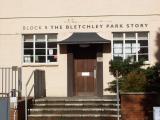
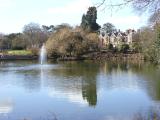
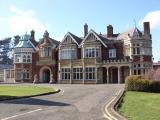
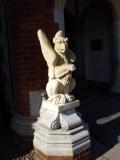
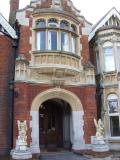
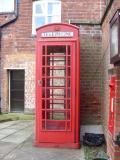
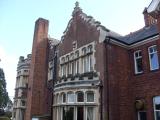
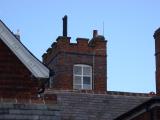
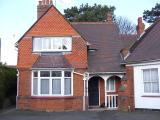
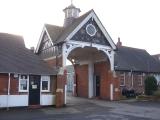
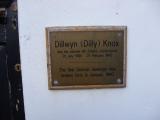
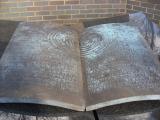
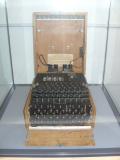
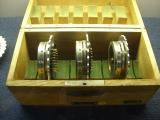
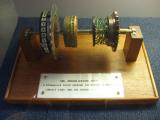
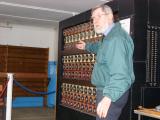
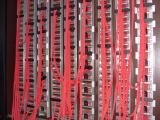
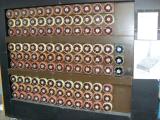
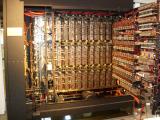
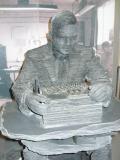
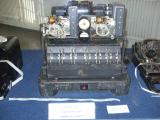
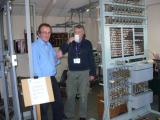
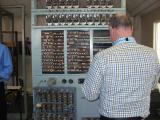
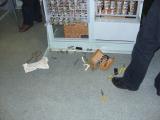
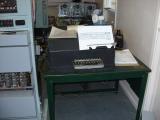
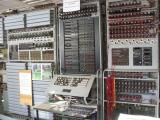
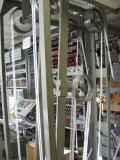
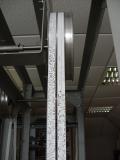
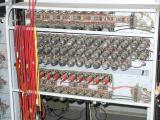
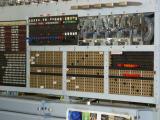
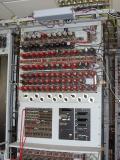
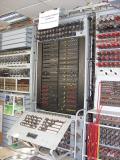
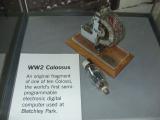
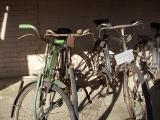
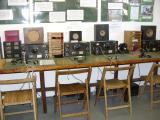
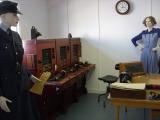
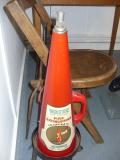
Jen and I visited England for about a week in March, 2010. It was our first trip to the United Kingdom. We spent most of our time in London, but got out to Bletchley Park near Milton Keynes and to a rugby union match in High Wycombe. March is not the best time of year to visit, as it was raining and cold a lot of the time. London was quite expensive. On the same trip, we also had a brief visit to Wales.
These photos are copyright © 2010 Kenneth E. Harker. All rights reserved.
The Bletchley Park National Codes Centre is the site of Britain's World War II efforts to break the secret codes of the Axis powers. Originally a country estate chosen because of its proximity to a major rail line, the site at one point was filled with huts where scientists and technicians built and operated the first programmable computers. Security at the site was exceptionally effective; the role that Bletchley Park played in the war effort remained secret for another 30 years after the conclusion of hostilities. Today, Bletchley Park is a short train ride from London and operated as a museum open to the public. We visited on an afternoon.
 |
The main museum entrance is in one of the original "Block" buildings. Aside from the manor house, the structures on the estate were either designated as "blocks" or "huts". The "blocks" were more substantial, permanent structures. The "huts" were wooden buildings, and unfortunately, many are now in serious disrepair. |
 |
A large pond in the center of the estate. The original manor house is on the far side of a lawn beyond the pond. |
 |
The manor house is an eclectic mix of Victorian Gothic, Tudor, and Dutch Baroque architectural styles. |
 |
A gargoyle near the front entrance to the manor house. |
 |
The front entrance to the manor house. |
 |
Around the side of the manor house is a telephone box. This one is not in working order, and is probably not the original one. The telephone box in service during the war was assigned a phone number on a London exchange in order to hide its actual location. |
 |
One side of the manor house. The chimney on this side of the house seems strangely plain compared to the rest of the building exterior. |
 |
At the very beginning of the war, antennas were attached to this tower in the center of the manor house. Station X was used to receive copies of German transmissions as intercepted by other listening posts. Fearing that operating a radio station from the estate would attract the attention of the Germans, the British soon stopped operating a station on the estate proper, and relied upon couriers and other means of transporting intercepted transmissions to the code breakers. |
 |
Some of the outbuildings of the original manor house complex. |
 |
This gate was attached to stables that were later used as garages for motor vehicles. |
 |
A plaque on one of the buildings. Knox was the cryptanalyst that first broke the German Enigma code. His mathematical techniques formed the basis of the machines that were built to break the coded transmissions in a timely manner for the rest of the war. |
 |
This memorial pays tribute to Polish cryptanalysts who did much of the early mathematical work to break the Enigma code. As it became evident that Nazi Germany was going to invade Poland, the intelligence that the Poles had collected was secretly given to the British intelligence community, giving them a head start on the task. The text on the left page is in English; on the right is in Polish. Nowhere in Bletchley Park are the Polish mathematicians listed by name. |
 |
One of the German Enigma machines. Enigma was the day-to-day operational code used by the German military. It was used for everything from weather reports to personnel orders to simple logistics. |
 |
Each Enigma machine had "rotors", which look like fat gears. Enigma machines used by the German Army had three rotors and Enigma machines used by the German Navy had four rotors. |
 |
Inside the rotors, complex point-to-point wiring electrically translates each letter to a different letter. The combination of three rotors and all the possible combinations of orders and starting positions made messages encoded with Enigma difficult to break at all, and very slow to break by hand. |
 |
A tour guide talks to us about one of the replica Bombes. These mechanical devices automated the task of finding valid rotor settings on the Enigma machine that could have created the coded transmission. |
 |
The back side of the Bombe is a mass of wires and plugs. I loved the way that the individual wires are braided into cables. Each day, the German codes would change, requiring a re-wiring of the Bombe. |
 |
The front of the Bombe. When the Bombe finished its run, the three black rotors on the right would indicate a potential setting for the Enigma machine. The process was not perfect, and sometimes the Bombe would have to be run multiple times before a rotor combination was found that resulted in decrypted German plain text. |
 |
Inside the Bombe is mostly mechanical relays and point-to-point wiring. The Bombe is not considered a general purpose computer. It was designed to solve one very specific kind of problem and could not be easily re-purposed to other tasks. |
 |
A statue of Alan Turing. Turing is considered one of the fathers of computer science, developing the early formal concepts of algorithms and computability. At Bletchley Park, he was responsible for the mechanical design of the Bombes that broke the Enigma code. In 1952, he was prosecuted as a homosexual (which was a crime at the time) and was given female hormone treatments in lieu of incarceration. Tragically, this brilliant scientist and liberator of Europe committed suicide in 1954 at age 41. In 2009, Prime Minister Gordon Brown issued a formal apology on behalf of the British government for the way it treated Alan Turing after the war. |
 |
An original WWII German Lorenz machine. Lorenz was a much more complex code than Enigma, reserved for very high-level communications. The machine has 12 rotors rather than 3 and used punch tape to encode and decode messages. The Germans had more trust in Lorenz. Rather than changing the rotor settings daily, the same settings could be used for a month at a time, giving the British more time to break the codes with Colossus. |
 |
Our next stop was the building housing a replica Colossus, the first programmable computer in the world. Colossus was built to crack the German Lorenz code. The replica Colossus has been built by volunteers (including many amateur radio operators), some of whom were on hand working on the computer. |
 |
Almost all of the discrete components for this replica Colossus had to be built by hand. Even capacitors and resistors are made from different materials and in different sizes today than they were in the 1940s. Nortel was one of the big sponsors of the project, and many of the volunteers were Nortel or ex-Nortel employees. |
 |
Some hand tools on the floor. |
 |
The Lorenz code was only used with teleprinter transmissions, rather than with telegraphy transmissions. As a result, Colossus used a teleprinter interface for input/output. |
 |
The main control panel of Colossus was too large to fit into one photo. The main bank in the center was full of small lamps indicating the internal state of the machine. Notice also the banks of vacuum tubes ("valves" as they are called in Britain). A typical radio set of the day might have two or three vacuum tubes in it. The first Colossus Mk 1 had 1,500 tubes. This is a replica of the Mk2, which had 2,400 vacuum tubes. |
 |
Colossus used punched tape for storage. Captured transmissions would be recorded on the punch tape, which would be loaded into this mechanical assembly for rapid input into the computer memory. |
 |
What the punched tape looked like. |
 |
Some of the vacuum tubes in Colossus. Vacuum tubes had a reasonably high failure rate in the 1940s, but most of the failures occurred when the tubes were first turned on. So, once the Colossus machines were turned on with all tubes functional, they were never turned off except when they malfunctioned or required repair. |
 |
Some of the programmable interface to the Colossus. |
 |
More vacuum tubes in the front control panel of the computer. |
 |
Another view of the Colossus front display area. |
 |
Some parts from the original Colossus. By the end of World War II, ten Colossus computers were in use. None survive today. |
 |
Back outside, in front of one of the huts, some WWII-era bicycles are slowly rusting. |
 |
A display of World War II vintage wireless receiving sets and headphones. |
 |
A replica wireless receiving station. Receiving stations were scattered throughout the United Kingdom and British-held territory. When a German transmission was copied, it would be forwarded to Bletchley Park for cryptanalysis. |
 |
World War II era fire extinguisher. |
We spent only a couple of hours in Milton Keynes, a bedroom community northwest of London because it was on the train line and it looked convenient for dinner. It has no real tourist attractions, but sometimes that makes a place interesting as well. We spent some time in a grocery store marvelling at how many different shapes and sizes of chocolate Easter eggs were on sale.
The Tower of London is a castle that has served the English government as a fortress, palace, prison, armory, mint, treasury, and place of execution. The oldest portions of the castle were built in 1078 by William the Conqueror (1028-1087). Today, the Tower of London is a World Heritage Site maintained by an independent charity, supported in large part by ticket sales to visitors.
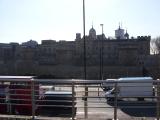 |
A view of the Tower of London from the outdoor plaza at the entrance to the London Underground Tower Hill station. |
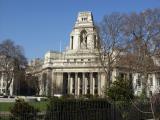 |
A building on Trinity Square across the street from the Tower. |
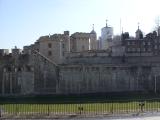 |
The outer wall of the Tower of London. |
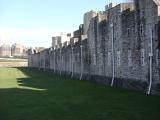 |
Another view of the outer walls of the Tower of London. |
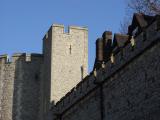 |
Battlements at the top of Byward Tower. |
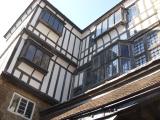 |
As the Tower was in continuous use by the English monarchy for centuries, various styles of architecture can be found throughout the castle. These apartments in the Queen's House were from the Elizabethan era. |
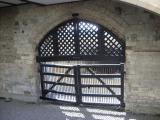 |
The water gate entrance to the Tower of London is sometimes called the Traitor's Gate, as it was the entrance used by several famous condemned prisoners on their way to eventual execution in the Tower. |
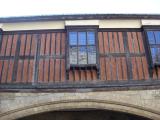 |
A reflection of the tower walls in the windows at St. Thomas's Tower. |
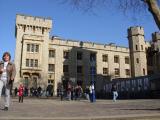 |
The Waterloo Barracks today hold the Crown Jewels. The construction wall on the right was part of the temporary wall around the White Tower during exterior renovations. |
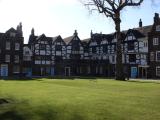 |
The Queen's House. |
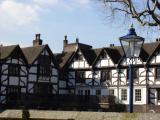 |
The Queen's House apartments were not open to the public. |
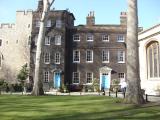 |
The Beauchamp Tower. The lawn in front of the building is known as the Execution Block. |
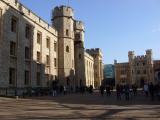 |
The Waterloo Barracks are sometimes also called the Jewel House. |
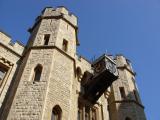 |
The giant, three-sided clock on the Waterloo Barracks was probably a later addition. |
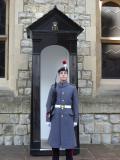 |
A guard in front of the building, guarding the Crown Jewels. |
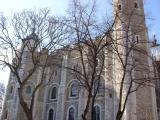 |
One side of the White Tower, the central keep in the castle. The White Tower was being cleaned and renovated while we were there, so some sides of the keep were covered in scaffolding. |
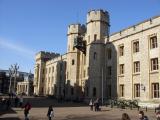 |
Another view of the Waterloo Barracks. |
 |
Jen, in the sunshine. |
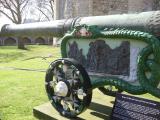 |
This cannon was on display on the lawn in front of the White Tower. The Tower of London was used as an armory for the British Army for many years. |
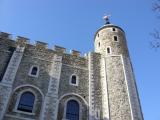 |
One of the corners of the White Tower. |
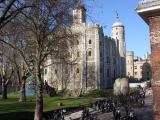 |
The White Tower at the center of the Tower of London. |
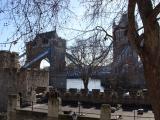 |
The Tower Bridge crosses the River Thames next to the Tower of London. |
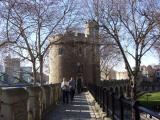 |
Walking along the wall between the Lanthorn Tower and the Salt Tower. |
The Parliament of the United Kingdom meets in the Palace of Westminster, a building that dates back to the reign of William II (1056-1100). The Palace of Westminster was originally a royal palace, but after a major fire in 1512 has housed the Parliament. Parliament is the supreme legislative and executive body of the United Kingdom and is composed of two houses: the House of Commons and the House of Lords. We visited the Parliament one afternoon and had a chance to sit in the Visitors Gallery of the House of Lords during a session of debate. Photographs inside were not allowed beyond Westminster Hall.
Westminster Abbey is a large Gothic Anglican Church just west of the Palace of Westminster. It is the church used for royal coronations, funerals, and even burials. A church has been at this site since the year 960. King Harold II (1022-1066), the last of the Saxon kings, was crowned in a Romanesque church at this site in 1066, just months before being killed in battle fighting the invading army of William the Conqueror (1028-1087). The current Gothic church building was constructed over a long period of time from 1245 to 1517. The church was closed by the time we arrived in the afternoon after the visit to Parliament.
Some photos I took walking around greater London.
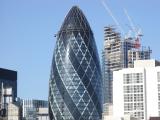 |
One of the distinctive buildings of London, as seen from the walls of the Tower of London. This is the London headquarters building of Swiss Re, an insurance company. The building is sometimes referred to as the "Gherkin Building" due to its shape resembling a pickle. |
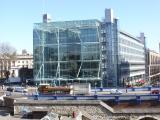 |
A distinctive building across the street from the Tower of London, at St. Katharine's Docks. |
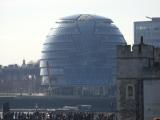 |
This building, across the Thames River from the Tower of London, is the London City Hall. |
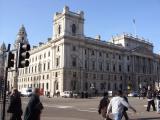 |
One of the government buildings across the street from Parliament. |
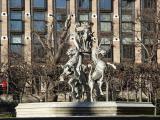 |
A statue on the street outside Parliament. |
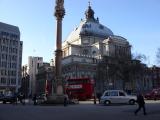 |
A statue and building across the street from Westminster Abbey. A red double-decker city bus is passing behind the statue. |
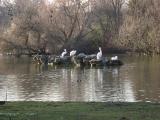 |
Some waterfowl in a small pond in St. James's Park. |
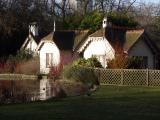 |
A cottage in St. James's Park. This cottage was originally built in 1841 as a residence for the park's birdkeepers. It was damaged by a bomb in the Second World War, but has since been restored. Today, it is used as the headquarters of the London Historic Parks and Gardens Trust. |
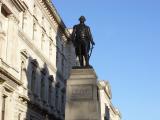 |
A statue of Robert Clive (1725-1744), also known as Clive of India. Clive was one of the most important figures in the East India Company, and is credited with securing India for the British crown. After retiring to an English country estate in Surrey, he suffered from depression and drug addiction. He killed himself at his city home in London in 1744 by stabbing himself with a pen knife. |
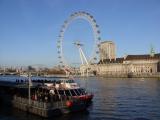 |
The London Eye was the tallest Ferris wheel in the world when it was built in 1999 to celebrate the new millennium. It is 135 meters (443 feet) tall. Since 1999, two larger Ferris wheels have been built (one in China and one in Singapore) but the London Eye remains the tallest design with a cantilevered support on only one side of the wheel. The building to the right of the wheel is the Sea Life London Aquarium. We did not visit either attraction. |
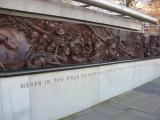 |
The Battle of Britain Monument is a high relief panel sculpture on the Victoria Embankment overlooking the River Thames. This part included the famous quote of Winston Churchill. |
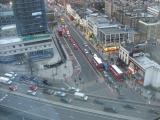 |
A view of the London city traffic from our hotel window near the Edgeware Road Underground station. |
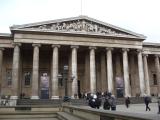 |
The British Museum was founded in 1753 and is one of the largest museums of history and culture in the world. |
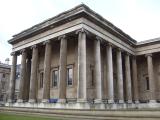 |
Many of the classical items in the collections from the Mediterranean and Middle East are the subject of controversy, with the countries of origin demanding their repatriation. |
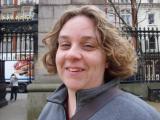 |
Jen, in front of the British Museum. |
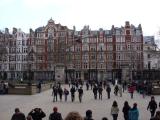 |
The row houses across the street from the museum were typical of the older homes we saw in central London. |
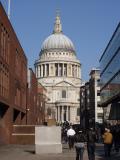 |
St. Paul's Cathedral is a landmark Anglican church in central London. Although a church has been on the site since 604 AD, this structure was built after the Great Fire of 1666 burned the previous Cathedral to the ground. This church building was designed by Christopher Wren (1632-1723), who presented the first model for the design in 1668. The church was completed in 1697. It was the tallest building in London until 1962. |
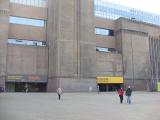 |
The Tate Modern is Britain's national museum of modern art. The museum is housed in a former electric power station on the south side of the Thames River. |
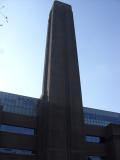 |
When the building was converted to a museum, the original smokestack was retained, and has become a recognizable architectural landmark. |
At 346 km (215 miles) long, the River Thames is the longest river in England. London was founded on the lower reaches of the river, but it also flows through other major cities and towns in England, including Oxford, Reading and Windsor. Most of greater London is located on the northern side of the Thames.
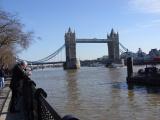 |
The Tower Bridge across the River Thames. |
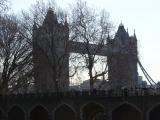 |
A view of the Tower Bridge. |
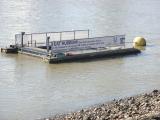 |
Some kind of garbage collection barge. |
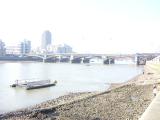 |
Looking west at the A201 bridge over the river at low tide. Although London is well upstream of the Thames Estuary, this portion of the river is still affected by tides. A flood barrier downstream of London protects the city from exceptionally high tides and storm surges. |
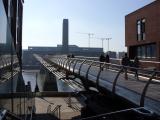 |
The Millennium Bridge is a pedestrian bridge crossing the River Thames. Built in 2000, as part of the city's millennial celebrations, it quickly earned the nickname "Wobbly Bridge" and was closed after just a few days. Engineers added dampers to the bridge to prevent vibrations causing the severe swaying, and the bridge was reopened in 2002. Up to 2,000 pedestrians can use the bridge at one time. The building in the distance is the Tate Modern. |
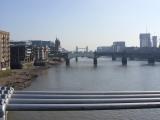 |
Looking east from the Millennium Bridge. The Tower Bridge is in the distance. |
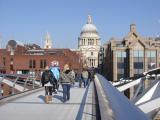 |
St. Paul's Cathedral, as seen from the Millennium Bridge. |
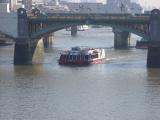 |
A ferry boat on the Thames. |
Since our honeymoon in New Zealand, I've been a big fan of rugby union football. On this trip, we were able to get tickets to an English Premiership (which, due to sponsorship is currently being called the Guinness Premiership) match between the home team London Wasps and the visiting Gloucester Rugby Club.
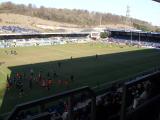 |
The game was played at a stadium called Adams Park, in the London suburb of High Wycombe. The stadium is actually owned by the Wycombe Wanderers, a soccer team, and shared by both clubs. It has a seating capacity of just over 10,000 spectators. Most of the seating is on the side of the field where spectators are not looking into the sun in the evenings (the side we were sitting on). |
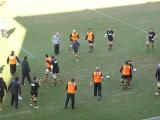 |
London Wasps players warming up before the game. The players wearing the orange vests are reserve players who can be put into the game as substitutes. The orange vests help ensure that they are not confused with players in the game should the play come close to the sidelines. |
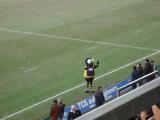 |
The London Wasps mascot is known as "Sting". |
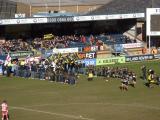 |
Player introductions. The red and white flags are the flag of England. The black and yellow flags are banners of the rugby football club. |
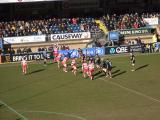 |
A line out early in the first half. The Gloucester players were in red and white and the Wasps were in black and yellow. |
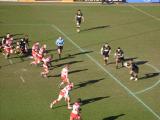 |
Open field play just before the Wasps scored their first try in the near corner. The blue lines on the field are demarcating the goal area of a soccer pitch and are irrelevant to the rugby match. The dashed white lines mark 5 meters from the try line and the sidelines in the rugby match. The solid white line behind the runner with the ball in hand is the 22 meter line, indicating 22 meters from the try line. The man in blue is the referee. |
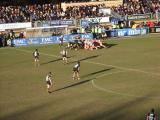 |
A scrum in the second half. The London Wasps won the game 42-26, although the game was close into the final 15 minutes or so. The Wasps would finish the season in fifth place out of 12 teams. Gloucester would finish the season in seventh place. |
| Last Updated 1 August 2018 |